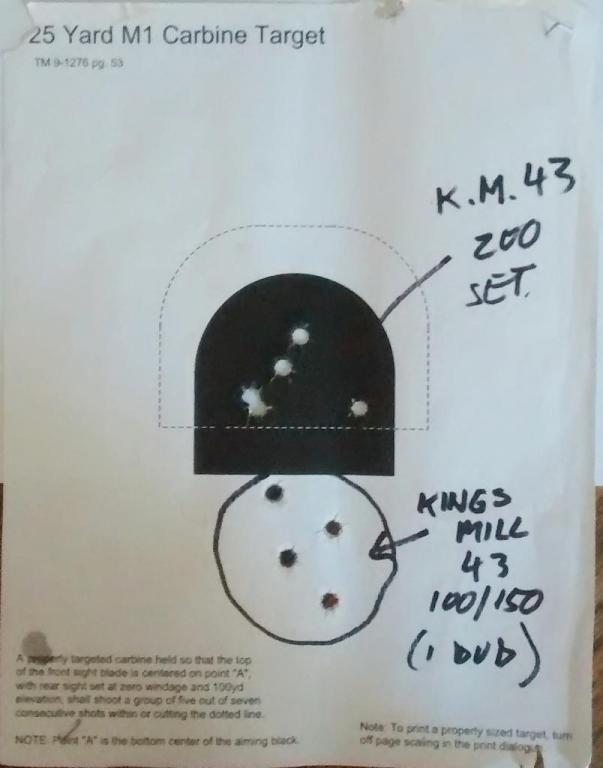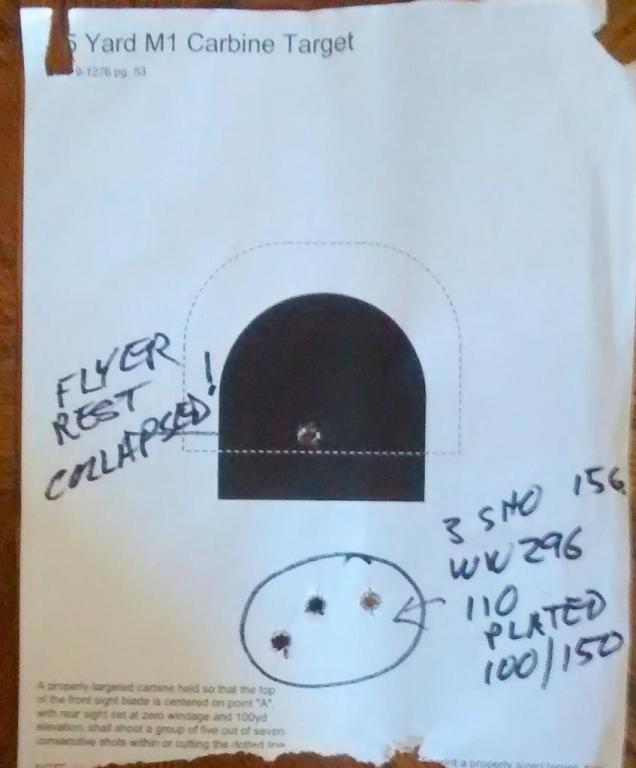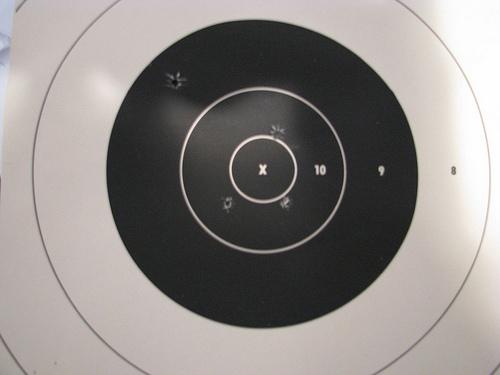-
Legacy Member

Dang I love this carbine! Sight-in pics
Got a chance to shoot my 6 digit Inland, post-war rebuild and regulate the sights at 25 yards from a rest. The weapons has seen zero use since the rebuild, and looks as good as a white bag carbine I had 10 or 12 years ago. It has been totally refinished with a dark charcoal color park job. The Underwood barrel (with only "-44" stamped on it with an ordnance bomb) has an ME of "0".

Went up in the forest and measured of 25 yards. Seat up an ersatz rest using a saw horse and a towel, and a lawn chair. The targets were GI 25 yard sight in targets. Thee trigger is tough at about 8-9 pounds. I will have to stone it to smooth it out. With that said, I started with Kings Mill '43 WW2 ammo. About 1 in 5 rounds had dead primers, but the ones that went off were great.
With the sight on the 100/150 setting, the windage was perfect, but it was printing about 1.5" to 2" below the dotted line for acceptable group. The front sight is tall and un-messed with, probably put on at rebuild. When I put it up on the 200 setting, the group was perfect. I tired some reloads, 15 grains of WW296 under a 110 Rainier Ballists plated bullet, and they printed almost the same as the Kings Mill. I did some plinking, shooting - standing, off-hand with it on 200 setting. Shot great, and killed lots of pine cones and dirt clods!
I will figure how much the front sight needs trimmed, and file it. It bothers me to have to use the 200 setting for 100 yards! If it was a collector weapon, it would be different. Anyone know how much higher the 200 setting is from the 100/150?


Information
 |
Warning: This is a relatively older thread
This discussion is older than 360 days. Some information contained in it may no longer be current. |
|
-
The Following 3 Members Say Thank You to imarangemaster For This Useful Post:
-
10-01-2014 06:05 PM
# ADS
Friends and Sponsors

-
Contributing Member


Its a fine looking Carbine....When i built my First Carbine and took it to the Club, i couldn't even shoot it like i wanted to, So many people where just begging to shoot it...Aren't these the best looking and shooting Rifles ever, Frank...SEMEPR FI
-
Thank You to imntxs554 For This Useful Post:
-
FREE MEMBER
NO Posting or PM's Allowed

I don't know how much higher from the 100 yard setting the peep is when set at 200 yards, but the drawings for the adjustable sight specify 0.110" higher when set at the 300 yard setting. So it's probably true that the 200 yard setting is 0.110"/2=0.055" higher than the 100 yard setting. However, I have neither the time nor inclination to go through the drawings in detail to verify that this is so for you.
-
Legacy Member

I can figure it out with math. Divide the inches in 25 yards (900 inches) by the sight radius (21.4 inches) = 42 sight radii and change. Then divide the amount I want to raise the impact by the (2 inches) by the 42 sight radii, and that (.0476") Which would be around 1/24th of an inch should be the amount to file the front sight.
-
-
Legacy Member

One thing one does not do to a carbine is to fill or stone a trigger or a sear. If you do not have a type two trigger and type 3 sear then replace these parts to improve a trigger pull. By working on a trigger or sear you run the chance for the carbine to double or even more when fired.
-
The Following 2 Members Say Thank You to Bruce McAskill For This Useful Post:
-
Legacy Member

I have feeler gauges. I'll do .045" and see what happens.
-
-
Legacy Member

You could get a Dial Caliper. They are handy when reloading too. GK
M1a1's-R-FUN!!!!!!!!!!!!!!!!!!!!!!!!
TSMG's-R-MORE FUN!!!!!!!!!!!!!
ENJOY LIFE AND HAVE FUN!!!
-
-
Legacy Member

His math checks out . When I did all my carbines , it was about .006 per inch of adjustment . 25 yards is 4x closer , so about .024 per inch at 25. 2 inches , about .048 .
I did quite a bit of carbine shooting before it got hot this summer . Went out to 300 yds with 6-8 of my carbines . I found that if the 100 yd setting was in the center of a 6-inch bull w/6-o'clock hold , the 200 yard group was in it's 6-inch bull and the 250 yd group was in it's 12-inch bull . The 300 yd group , however , varied from a little below that 12-inch bull , to in it , to over the top of the target frame. It seems to be linked to the type2 vs type3 vs actual maker. There is reports that carbine ammo was loaded lighter in Korea than WW2 and the Korean winter temps had an effect . They might have increased the slop on the rear sights to correct the greater drop less velocity would cause . I had not heard of this before . I'll test more this fall , though the weather may effect the results.
Chris
Oh , BTW , the adjustment between the ranges gets greater as it goes out . To test YOUR sight , set up at 100 and shoot the different settings and measure . It's the only way to be sure of YOUR sight .
-
Thank You to emmagee1917 For This Useful Post:
-
Legacy Member

Before cutting the sight, make sure you have some fresh, hot ammo to use - the closest to mil-spec (110 gr @1990 FPS) you can find. A lot of .30 Carbine today is under-powered. Also consult the drawings for the correct angle on the sight blade - the front should be a little lower than the rear. I applaud your efforts to dial it in correctly!
-
Thank You to INLAND44 For This Useful Post:
-
Legacy Member

Bruce's points are well taken. Any stoning or dressing on the trigger pieces is just taking off the very thin hard facing layer and then they wear pretty rapid after that. The latest sears by Winchester and Inland have these parts polished from the factory, the ends being bright metal. I might try a slightly weaker trigger spring but not much beyond that. Selective assembly is the best answer. I also lube these contact points on my carbines, something that is absolutely not done on the big M1 rifle. The oil or grease seems to help somewhat with no ill effects. By design, the carbine trigger is more about safety than accurate shooting. My NPM has the best trigger. Here's a SR-1 shot at 100 yds with handloads.
rifle. The oil or grease seems to help somewhat with no ill effects. By design, the carbine trigger is more about safety than accurate shooting. My NPM has the best trigger. Here's a SR-1 shot at 100 yds with handloads.

-
 Information
Information
















 PM
PM











